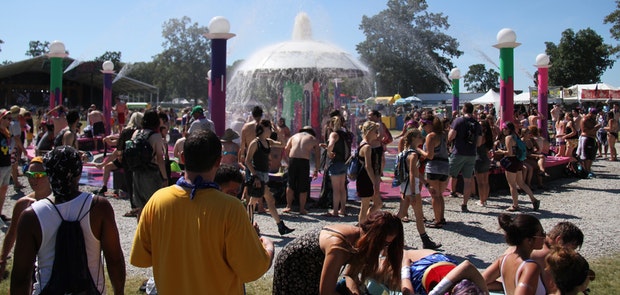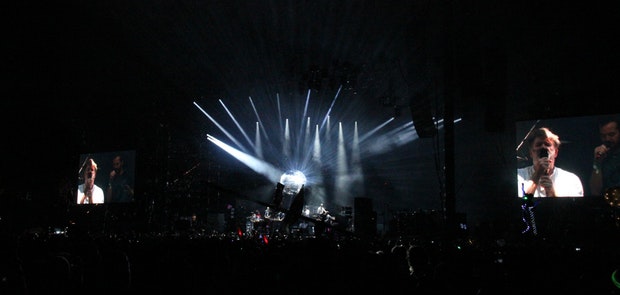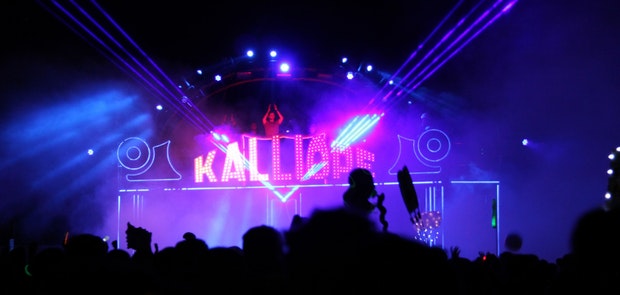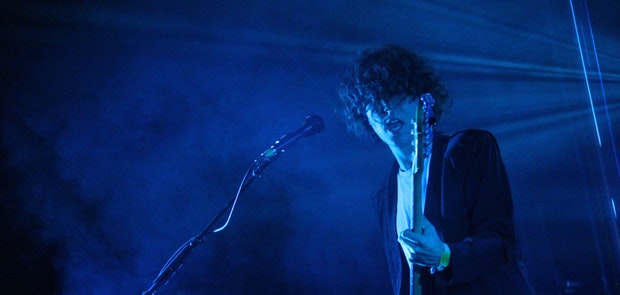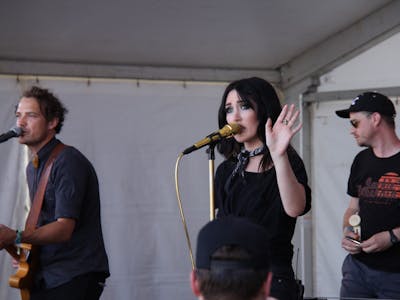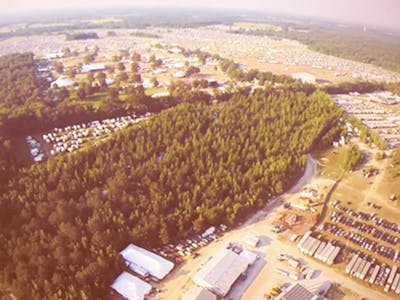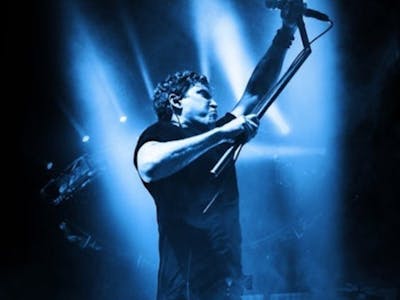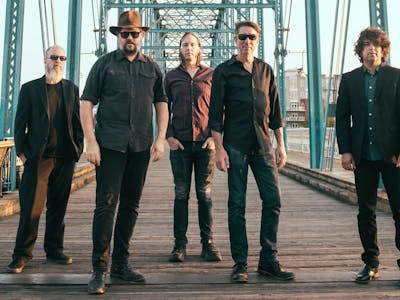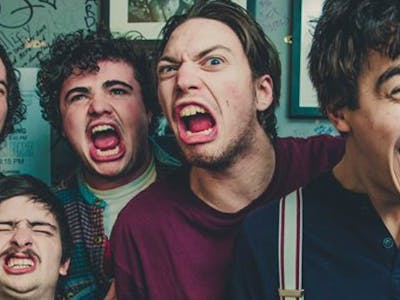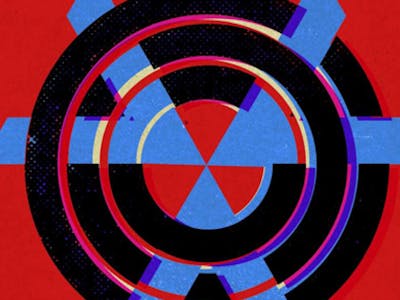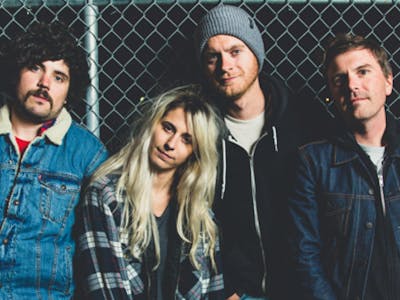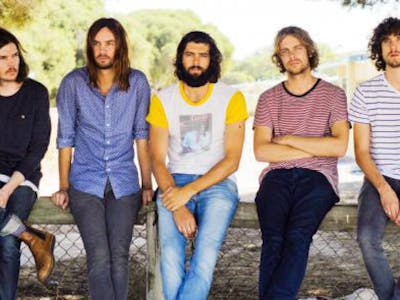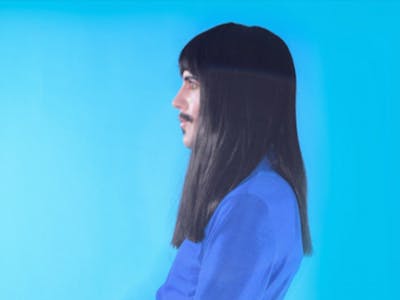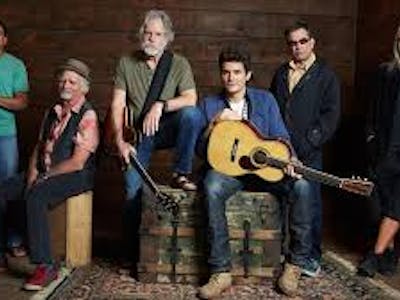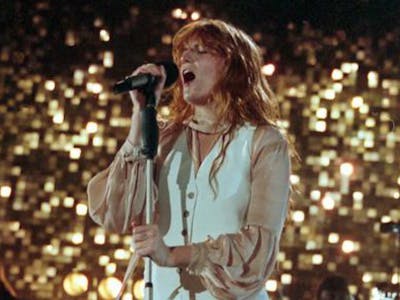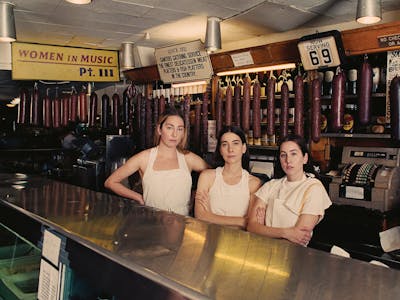For a decade and a half now, Bonnaroo has stood alone on the American festival scene. Although other American festivals have higher annual attendance (Lollapalooza regularly breaks 100,000) or pull rarer gets (even entering its tamer years, Coachella still reigns supreme for reunions), only Bonnaroo equals the epic sprawl of the marquee European stalwarts, turning the Tennessee landscape into a rolling tent city every June with wall-to-wall programming for a ridiculous 83 straight hours. In its fifteenth year, the festival underwent some significant changes--for better and for worse--and suffered from surprisingly low attendance, but remained, at its heart, the same overwhelming, panoramic behemoth that it’s always been.
View the full photo gallery here
The weather played a major role in the weekend’s proceedings. Never have I experienced such an extreme weekend on the Farm; the actual temperature spiked to a scorching 99 degrees on Friday, and as the humidity rose further into the festival, the heat index approached 110. This turned an already intense weekend into a grueling physical endeavor, and many attendees (your correspondents included) reported skipping some planned sets entirely in the name of recuperating. There was some reprieve in the three massive tents, but even in the shade, the swampy air was pervasive. Sunday, which featured the strongest start-to-finish slate of the weekend on the two major outdoor stages, was particularly brutal. But folks persevered, and once the sun set beside the banks of pines on the western edge of the Centeroo site each night, things got cool enough to require covering up.
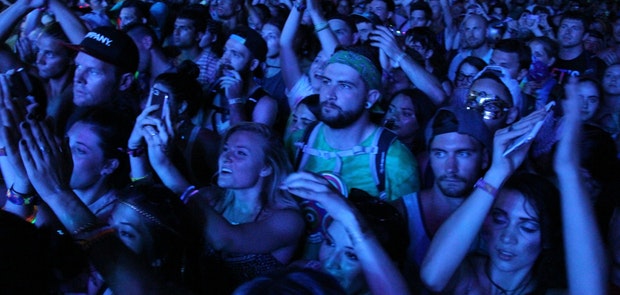
Weather also altered the narrative when a small Saturday thunderstorm cell passed through town north of the festival grounds. As HAIM finished up their (fantastic) set on Which Stage with the sunset behind them, the sky to the north had turned an apocalyptic shade of black, and horseshoes of lightning arced from cloud to cloud. The final strains of “Forever” were cut off by an announcement calling for an evacuation of Centeroo, and fans were told to seek shelter in their vehicles. The worst we got was a bit of drizzle, but better safe than sorry. The storm did wreak havoc on the evening’s schedule, though; Pearl Jam’s set was bumped by an hour and a quarter to 11:30, and sets at other stages were jumbled and shortened. The site evacuation is not a common occurrence at Bonnaroo, a first in our experience, but the efficiency and ease with which organizers handled the proceedings speaks volumes about just how prepared they are.
Of course, music is paramount at Bonnaroo, and one artist needs to be discussed before the rest: LCD Soundsystem’s Friday headlining set gripped the crowd like a fever dream from the opener “Us V. Them” and didn’t let go. The band was a controversial choice for top-line billing, enjoying popular but cult status during their initial run, elevated in their absence by their epic 2011 farewell concert and subsequent documentary, but their long-rumored return has, for this summer at least, moved them to the top tier. On Friday, those further back reported a sparse crowd by Bonnaroo headliner standards (more on this later), but up front, the diehards were rabid and ready for their heroes to return. Simply put, this is the greatest live band modern music has to offer; paradoxically locked tight into every complex groove yet loose enough to turn on a dime at James Murphy’s brilliantly micromanaged direction, and propelled by Pat Mahoney’s superhuman drumming. At every moment, they have complete control over tension and release, edging the audience along before hurling us over the cliff of one climax after another: “Get Innocuous,” “Movement,” and the successive, Himalayan peaks of “Yeah.” The latter noisily found its way into the “Someone Great,” reeling with an unnamed loss, before a sharp 180 into “Losing My Edge,” which saw Murphy ad libbing (fictional) song structure advice to Captain Beefheart.
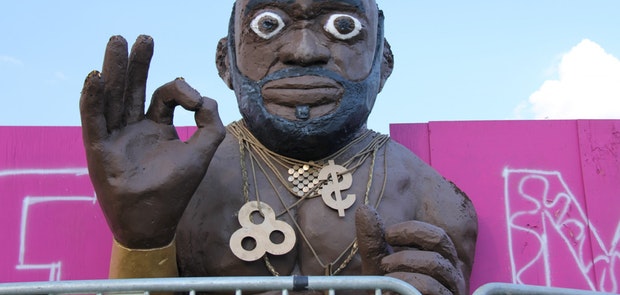
Throughout the set, the music was augmented by crafty but unobtrusive video production, carefully sequenced lights, and one colossal disco ball which rose blindingly during the opener and loomed, twinkling above the stage, for the rest of the set. The nine members of the Brooklyn band had already solidly established the set as one of the best in the history of the festival, but took things up a notch to finish up. “Dance Yrself Clean,” which famously opened the Shut Up and Play the Hits, took the penultimate spot here, and the packed pit at the front exploded with the concussive synthesizer blasts. But even by the impossibly high standards of LCD Soundsystem’s catalog, one song stands above the rest, and they saved it for the end. A nuanced rumination on lost youth and faded friendships, “All My Friends” opens like a great American novel and closes with a tangled existential panic attack, slowly building over seven minutes on the same two chords like some unknown relic of Bowie’s Berlin years, before bursting through to its stratospheric payoff. This was a perfectly constructed and executed set of music, one which not only stands as the greatest Bonnaroo performance I’ve ever seen, but possibly the strongest and most powerful concert in all my years of show going.
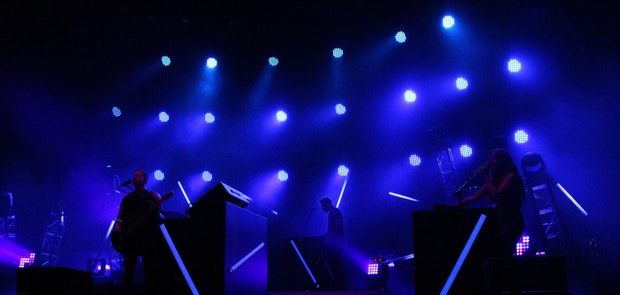
So with that out of the way, I should address the other two headliners, both of whom also put on epic sets worthy of the Bonnaroo history books. Rock legends Pearl Jam, on the cusp of the Rock and Roll Hall of Fame, returned after an eight-year absence, and wasted no time roaring into the jagged fray of “Go,” The band was in a cheery mood, thanking the crowd for waiting out the weather (cue the suddenly-obligatory “Lightning Bolt”) and pounding out a condensed set that focused on the hits; only three songs from the band’s post-Yield output made the cut, and they played two thirds of their Diamond-certified 1992 debut Ten. At 52, Eddie Vedder is still a kinetic presence, wielding the mic stand like a weapon and hurling himself into the crowd during the intense “Porch,” which closed the main set. Mike McCready held court at stage left, launching volley after volley of guitar wizardry on the likes of “Corduroy” and “Even Flow.” A lengthy encore featured a quick birthday celebration for Vedder’s daughter Olivia, who “blew out” a sea of illuminated cellphones, and what could have been a cheesy moment resulted in goosebumps. From start to finish, the crowd sang along loudly and passionately, raising in one collective voice on “Given to Fly” and a cover of Pink Floyd’s “Comfortably Numb.” The band effortlessly proved their continued relevance and enduring status with this crowd-pleaser, sending us off into the Tennessee night with their rendition of “Rockin’ In The Free World,” eerily prescient in retrospect given the events that were unfolding at that very moment in Orlando.
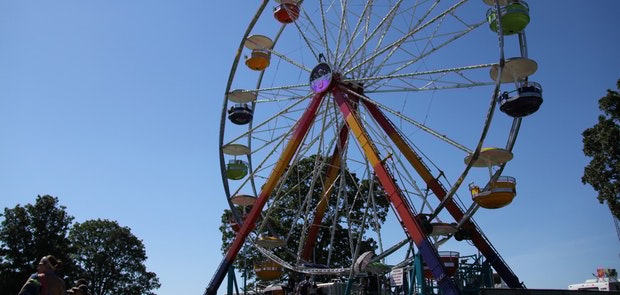
On Sunday night, current Grateful Dead Iteration Dead & Co. brought things to a close in suitably epic fashion over the course of two sets and nearly four hours. In many ways, the Dead is the heart and soul of Bonnaroo, which was originally dedicated to their jam band descendants, and its members graced its stages each of the festival’s first seven years. This permutation features Bob Weir on guitar and lead vocals, original drummers Mickey Hart and Bill Kreutzmann, left-field pick John Mayer (who unexpectedly fits in perfectly) on guitar and vocals, longtime Allman Brothers bassist Oteil Burbridge, and jam journeyman Jeff Chimenti on keys. They have no agenda beyond carrying on the 50-year legacy of one of American music’s greatest institutions, and before long a loose warmup jam found its way into the staccato storytelling of the iconic classic “Truckin’,” and we were off on a long, strange trip. Weir is definitely the bandleader, but Mayer holds his own, neither aping Jerry Garcia’s style (as Furthur guitarist John Kadlecik was wont to do) nor resorting to hackneyed blues riffs. In a weekend full of unexpected guest appearances, the most shocking (from a historical perspective) was saved for last: vocalist Donna Jean Godchaux, a full-fledged member starting in 1972, made her first appearance with a version of the Dead in 37 years, dating back to her 1979 departure. Diehards and younger Deadheads looked on dumbfounded as she was introduced, and she remained onstage for much of the night.

As much as is possible with their catalog, Dead & Co.’s sets were also a greatest hits affair, unleashing heavy hitters like “Terrapin Station,” “The Other One” (whose normally thundering opening riff fell a bit flat), and the timeless coupling of “Scarlet Begonias” and “Fire on the Mountain.” This was the band’s second show back after a promising initial run of arena shows last fall, but they seem to have finally found their groove, jamming effortlessly but never aimlessly. After a defiant encore of “Touch of Grey,” Weir joined the ranks of the many artists who addressed the Orlando tragedy from the stage, doing so in particularly angry fashion. “Is there a difference between that mindset,” he asked, referring to homophobic tweets by a Texas lawmaker, “and the mindset of the folks in the Taliban or ISIS? The hatred and intolerance is the same, they may pull it out of different books, but it's the same fucking thing. Register and vote, get those assholes out of there." That was the note upon which Bonnaroo 2016 ended, and I hope it’s still ringing in the ears of thousands on their way home.
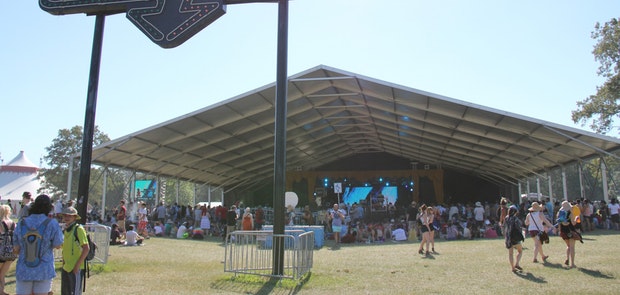
Aside from the headliners, Los Angeles saxophonist Kamasi Washington emerged as one of the big stars of the weekend. After an Early-Friday guest spot with singer Andra Day (whose set was a gorgeous, soulful affair), he tore down This Tent with a set largely drawn from last year’s sprawling masterpiece The Epic. Jazz is uncommon at major American rock festivals, but Washington seems to have broken down all barriers of genre restriction, and put on one of the best shows of the weekend. Washington also headlined the Saturday night Superjam, a tribute to Tennessee with featured guest appearances both poignant (Lizzo covering Tina Turner’s “I Can’t Stand the Rain”) and delightfully bizarre (Third Eye Blind’s take on “Ring of Fire”). Some complained that this year’s Superjam lacked the star power of some prior versions (which have starred the likes of everyone from R. Kelly to My Morning Jacket’s Jim James), but in Washington’s capable hands (and those of his out-of-this-world ensemble), it was a welcome delight at the end of a very, very long day.
Many returning acts put on noteworthy sets as well, some of whom graduated to much larger stages. Tame Impala lorded over the late night Friday scene with a technicolor rager on Which Stage, which drew a massive crowd that was pummeled by wave after wave of rainbow confetti. Kevin Parker and company had no trouble bringing the massive sound of last year’s Currents to life, and the synchronized IMAX-sized projections cast a trippy haze over the proceedings. “Let It Happen” is as remarkable live as it is on record, leaping from one melody to another without ever quite landing in one spot, and the bass-driven riffs to “Less I Know the Better” and “Elephant” reverberated through our bones. Some in the crowd were disappointed when the set ended after “New Person, Same Old Mistakes,” just over half an hour short of its scheduled two hours, but the quintet performed their full arena set and left it all onstage in one of the weekend’s great triumphs.
Nashville-via-Alabama songwriter Jason Isbell marked the release of his breakthrough album Southeastern at Bonnaroo three years ago, and his return marked his debut on the enormous What Stage on Sunday afternoon. This time armed with songs from Southeastern follow-up Something More Than Free, Isbell and his crack band the 400 Unit (featuring his ludicrously talented wife Amanda Shires on fiddle) owned the space for an hour. The newer songs were well-received by the crowd, but “Cover Me Up,” his semi-autobiographical statement of sobriety and fidelity, and “Never Gonna Change,” dating back to his time in Drive-By Truckers, were the real showstoppers.
Death Cab for Cutie subheadlined on Sunday, returning after an eight-year absence, and deserved a significantly longer set than the hour they were given (Florence + The Machine befell the same fate in the same timeslot a year ago). But they made the most of it, opening with “The New Year” and keeping a good mix of old and new. By request of unofficial Bonnaroo mayor/spirit animal Chance the Rapper (who, as with last year, was omnipresent all weekend despite not being on the lineup), Ben Gibbard picked up an acoustic guitar mid-set to serenade us with “I Will Follow You Into The Dark,” and they stared down the setting sun with a beautiful rendition of “Transatlanticism” to close things out. Reunited alt-rock weirdos Ween put on a career-spanning clinic to close out Which Stage for the weekend, mixing their trademark humor with rocking riffs and virtuosic musicianship on the likes of “Buckingham Green” and “Spinal Meningitis (Got Me Down).”
Scottish synthpop masters CHVRCHES also made the jump to the big stage on Friday, and they proved to be a much more dynamic, exciting live act than they were on their Bones of What You Believe touring. Lauren Mayberry is electrifying, bolting from one side of the stage to another, and she delivers the lyrics with newfound intensity. In another unexpected cameo, the trio welcomed Paramore singer Hayley Williams to duet on a late-set rendition of “Bury It,” which they managed to top with a soaring run through “The Mother We Share.” North Carolina rapper J. Cole was elevated to top-line status on this year’s lineup, and drew an enormous crowd to his enthusiastic Friday set heavy on 2014 Forest Hills Drive, which he told us had just been certified double platinum. The set featured another Chance the Rapper cameo (on a wild ride through Chance’s “No Problem”), but Cole and his amazing band were the real stars, careening furiously through one Forest Hills hit after another, maximizing every second of their 75 minutes.
Not everything can be great at Bonnaroo, though, and Macklemore’s Saturday set was the exact opposite of J. Cole’s triumph. He relied heavily on cheap gimmicks and video interludes, one of which implied--jokingly, but nonetheless--that his father is black, something which an artist so preoccupied with his own white guilt and privilege should probably be more careful about. His set was bisected by the rain delay, and was not lacking in enthusiasm and energy, but it dripped with saccharine earnestness. A cameo by Cincinnatian Eric Nally partially saved the set-closing “Downtown,” but in all it was an embarrassing mess from an artist who still seems adrift after his initial success.
Much more impressive was Minneapolis rapper Lizzo, who plowed gleefully through an hour of her body-positive bangers on Thursday night, backed by two killer dancers and a DJ who was as likely to drop her own sick verse as she was to drop a beat. Lizzo returned for her aforementioned star turn during the SuperJam, and really established herself as a star in the making. Both of her appearances were exercises in pure, unadulterated, unforced joyful fun. That made it a perfect fit for Thursday, an evening which I have always loved at Bonnaroo. There’s a giddy optimism that pervades the Farm as the Ferris wheel starts to glow for the first time, and newly arrived Bonnaroovians, not yet touched by heat exhaustion or the effects of hard partying, surge wide-eyed and excited into the first slate of acts. Other standouts on Thursday included a blistering set from Nashville punks Bully, quickly asserting themselves as one of the best live bands on the festival circuit, and an admirably self-assured appearance by Chicago’s Twin Peaks, which boasts three lead singers, each with their own distinct songwriting styles, who merge their talents into throwback Stones-and-Kinks-gazing rock and roll.
There were many other newcomers who made a significant impact, as well. Long Beach rapper Vince Staples put on the best hip hop show of the weekend, lurking in the gloom of the dimly lit stage and effortlessly spitting lightning verses from his 2015 breakthrough Summertime ‘06. He also had some quips about the demographics of the audience he saw before him, musing about the festival’s “waterslide for white people.” The stage was much brighter for Richmond, Virginia songwriter Natalie Prass on Saturday. She played to a disappointingly tiny crowd in That Tent on Saturday, but her jazzy ballads won over everyone within earshot, and she even took the time to treat us to some glimpses of the follow-up to her brilliant debut. Steve Gunn played an equally small crowd in This Tent later the same afternoon, and had to contend with infuriating sound bleed from two different stages, which he clearly found exasperating, but he and his band transcended with a set drawn from the just-released Matador Records LP Eyes on the Lines.
Small crowds were the name of the game all weekend, though. It wasn’t noticeable when walking through open areas in Centeroo, which were still congested as ever, but at the stages, it was astonishingly easy to get a good spot. One circulating rumor put the weekend’s attendance at just over 50,000, a shocking number given that the festival has easily cracked 80,000 in recent years and even crested above 100,000 in its largest weekends. It’s hard to pinpoint the exact cause of this. Even with top-notch headliners, some felt the top-to-bottom lineup was a step backwards from last year’s (a debatable assertion), but there was also a spike in ticket prices following the festival’s acquisition by LiveNation, as well as a separate charge for camping for the first time in the event’s history. Most likely, it was a combination of factors, but in a way, it actually made for a more pleasant festival experience. Attendees entering through the highway and west entrances, notorious for lines that usually stretch for as many as 8 hours, reported waits ranging from a couple hours to no time at all, and the (relatively) sparsely populated campgrounds made for shorter walks for many.
But the LiveNation acquisition did come with some significant site improvements. Conan O’Brien’s focus on the new bathrooms, outfitted with flushing toilets, was more than a little bit goofy during his lineup announcement show back in January, but they did mark a significant milestone in the history of the Farm and the Bonnaroo experience. For the first time, water mains run to the site, and you could fill your CamelBak from a tap instead of the myriad wellwater fill stations. In addition, new shower and bathroom facilities were dotted across the campgrounds. Bonnaroo is still roughing it (especially in that heat), but you can hardly call it cheating to enjoy a few new creature comforts.
The horrific events in Orlando loomed understandably large over the proceedings of Sunday. Rainbow balloons were tied to the gates outside of the Bonnaroo Arch, and the Dead amended their logo to incorporate the same multicolored motif. In addition to Weir’s inspired speech at the end of the closing set, several other artists expressed their outrage, including a livid Stephan Jenkins from Third Eye Blind during the Sunday afternoon press conference. A shaken Jason Isbell, though, talked about how onstage seemed like the right place to be, and I couldn’t help but think about how he was right. Sure, Bonnaroo is a corporate rock festival. But it is also a place, year in and year out, that has always displayed the best in people. Generosity, blossoming friendships, the limitless, graceful kindness of strangers. People look out for one another, share their water, offer their food, and chat cheerily during lulls. Despite keeping in mind the mantra “if it’s inaccessible to the poor, it’s neither radical nor revolutionary,” Bonnaroo--the idea and the (very real) community--nonetheless stands defiantly in the face of the kind of hatred and evil that reared its head in Orlando late Saturday night. It has always, to me, been a place where I have witnessed not only great music, but truly glimpsed the very best that humanity has to offer. On Sunday, that made it the right place to be.
